|
Sponsored by |
|---|
|
|
|
-
Need help navigating the forum? Find out how to use our features here.
-
Did you know we have lots of smilies for you to use?
You are using an out of date browser. It may not display this or other websites correctly.
You should upgrade or use an alternative browser.
You should upgrade or use an alternative browser.
Lunacy I didn't know that!
- Thread starter CarolKing
- Start date
bulllee
Well-Known Member
How Turkey Tails Became a National Dish in Samoa
Americans’ appetite for the bird had unintended consequences.
BY MICHAEL CAROLANNOVEMBER 15, 2021How Turkey Tails Became a National Dish in Samoa
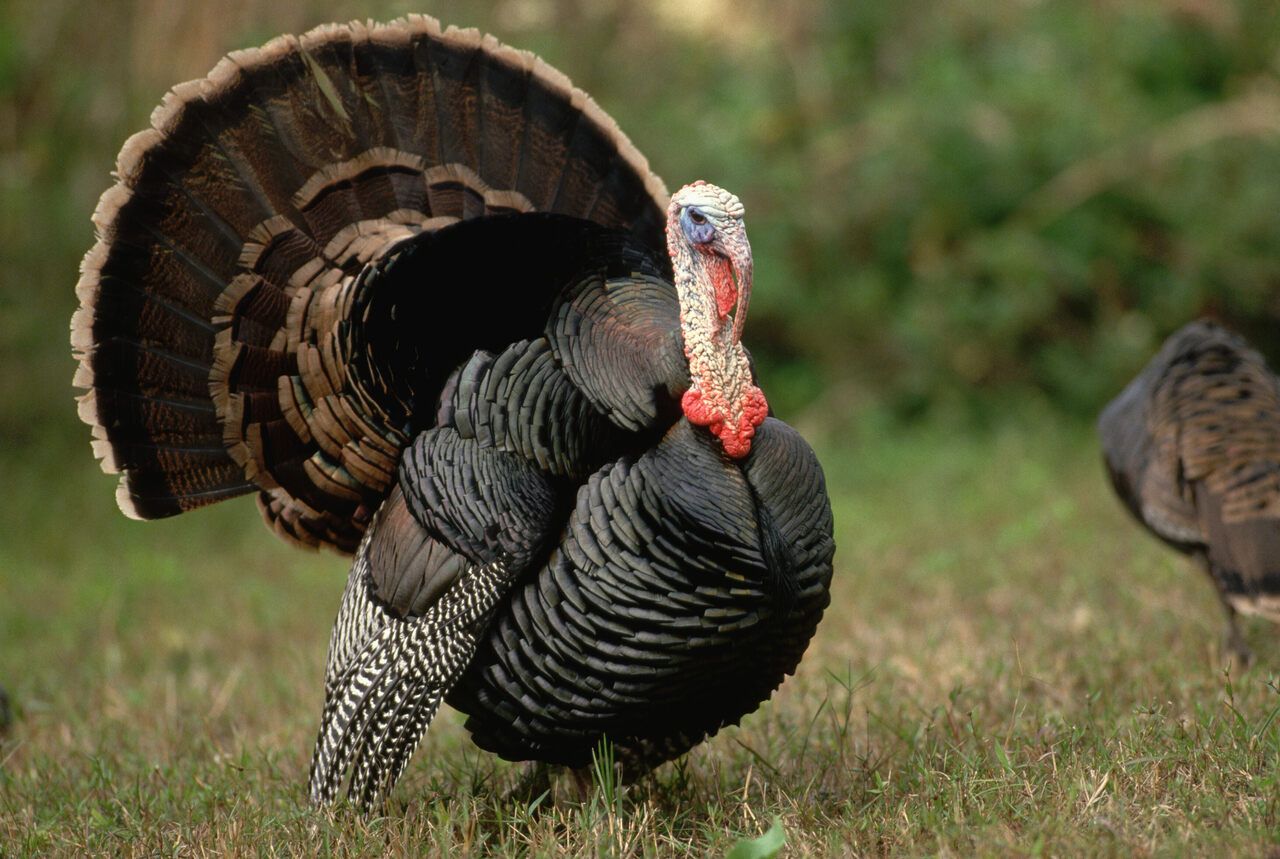
A wild turkey displays its tail feathers. JOE MCDONALD/GETTY
This story was originally published on The Conversation and appears here under a Creative Commons license.
INTENSIVE LIVESTOCK FARMING IS A huge global industry that serves up millions of tons of beef, pork, and poultry every year. When I asked one producer recently to name something his industry thinks about that consumers don’t, he replied, “Beaks and butts.” This was his shorthand for animal parts that consumers—especially in wealthy nations—don’t choose to eat.
On Thanksgiving, turkeys will adorn close to 90 percent of U.S. dinner tables. But one part of the bird never makes it to the groaning board, or even to the giblet bag: the tail. The fate of this fatty chunk of meat shows us the bizarre inner workings of our global food system, where eating more of one food produces less-desirable cuts and parts. This then creates demand elsewhere—so successfully in some instances that the foreign part becomes, over time, a national delicacy.
Industrial-scale livestock production evolved after World War II, supported by scientific advances such as antibiotics, growth hormones, and, in the case of the turkey, artificial insemination. (The bigger the tom, the harder it is for him to do what he’s supposed to do: procreate.) U.S. commercial turkey production increased from 16 million pounds in January 1960 to 500 million pounds in January 2017.
That includes a quarter-billion turkey tails, also known as the parson’s nose, pope’s nose, or sultan’s nose. The tail is actually a gland that attaches the turkey’s feathers to its body. It is filled with oil that the bird uses to preen itself, so about 75 percent of its calories come from fat.
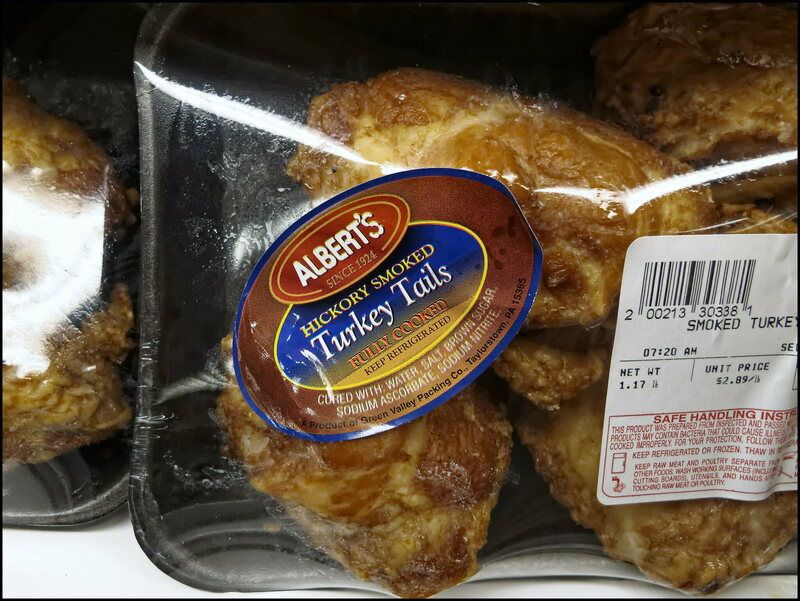
It’s not clear why turkeys arrive at U.S. stores tailless. Industry insiders have suggested to me that it may simply have been an economic decision. Turkey consumption was a novelty for most consumers before World War II, so few developed a taste for the tail, although the curious can find recipes online. Turkeys have become larger, averaging around 30 pounds today compared to 13 pounds in the 1930s. We’ve also been breeding for breast size, due to the American love affair with white meat: One prized, early big-breasted variety was called Bronze Mae West. Yet the tail remains.
Rather than letting turkey tails go to waste, the poultry industry saw a business opportunity. The target: Pacific Island communities, where animal protein was scarce. In the 1950s U.S. poultry firms began dumping turkey tails, along with chicken backs, into markets in Samoa. (Not to be outdone, New Zealand and Australia exported “mutton flaps,” also known as sheep bellies, to the Pacific Islands.) With this strategy, the turkey industry turned waste into gold.
By 2007 the average Samoan was consuming more than 44 pounds of turkey tails every year—a food that had been unknown there less than a century earlier. That’s nearly triple Americans’ annual per capita turkey consumption.
When I interviewed Samoans for my book No One Eats Alone: Food as a Social Enterprise, it was immediately clear that some considered this once-foreign food part of their island’s national cuisine. When I asked them to list popular “Samoan foods,” multiple people mentioned turkey tails, frequently washed down with a cold Budweiser.
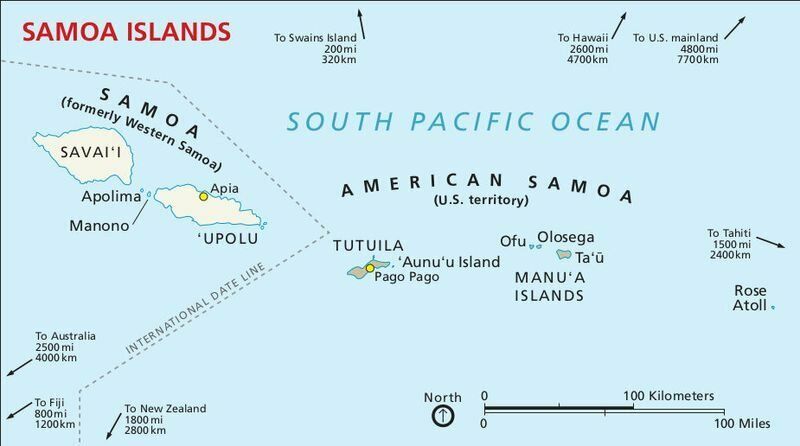
How did imported turkey tails become a favorite among Samoa’s working class? Here lies a lesson for health educators: The tastes of iconic foods cannot be separated from the environments in which they are eaten. The more convivial the atmosphere, the more likely people will be to have positive associations with the food.
Food companies have known this for generations. It’s why Coca-Cola has been ubiquitous in baseball parks for more than a century, and why many McDonald’s have PlayPlaces. It also explains our attachment to turkey and other classics at Thanksgiving. The holidays can be stressful, but they also are a lot of fun.
As Julia, a 20-something Samoan, explained to me, “You have to understand that we eat turkey tails at home with family. It’s a social food, not something you’ll eat when you’re alone.”
Turkey tails also come up in discussions of the health epidemic gripping these islands. American Samoa has an obesity rate of 75 percent. Samoan officials grew so concerned that they banned turkey tail imports in 2007.
But asking Samoans to abandon this cherished food overlooked its deep social attachments. Moreover, under World Trade Organization rules, countries and territories generally cannot unilaterally ban the import of commodities unless there are proven public health reasons for doing so. Samoa was forced to lift its ban in 2013 as a condition of joining the WTO, notwithstanding its health worries.
If Americans were more interested in eating turkey tails, some of our supply might stay at home. Can we bring back so called nose-to-tail animal consumption? This trend has gaining some ground in the United States, but mainly in a narrow foodie niche.I asked a producer to name something his industry thinks about that consumers don’t. He replied, “Beaks and butts.”
Beyond most Americans’ general squeamishness toward offal and tails, we have a knowledge problem. Who even knows how to carve a turkey anymore? Challenging diners to select, prepare, and eat whole animals is a pretty big ask.
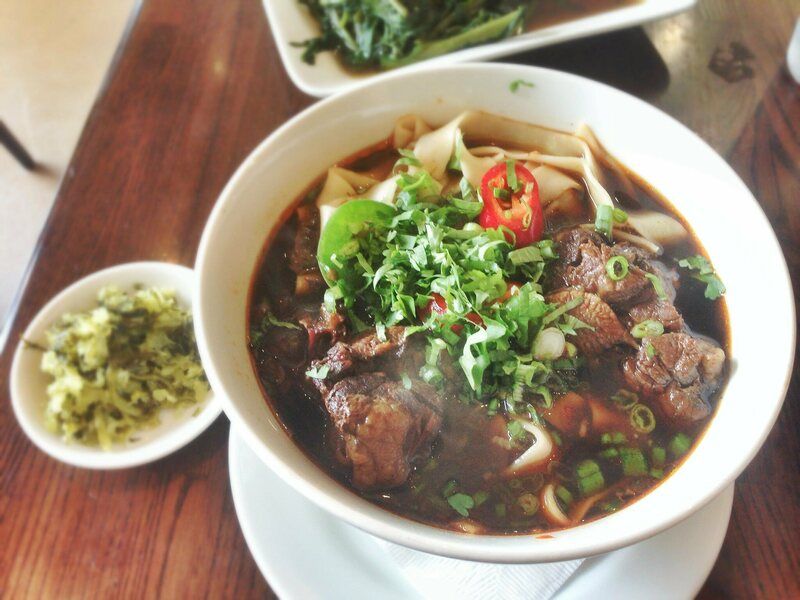
Google’s digitization of old cookbooks shows us that it wasn’t always so. The American Home Cook Book, published in 1864, instructs readers when choosing lamb to “observe the neck vein in the fore quarter, which should be of an azure-blue to denote quality and sweetness.” Or when selecting venison, “pass a knife along the bones of the haunches of the shoulders; if it smell [sic] sweet, the meat is new and good; if tainted, the fleshy parts of the side will look discolored, and the darker in proportion to its staleness.” Clearly, our ancestors knew food very differently than we do today.
It is not that we don’t know how to judge quality anymore. But the yardstick we use is calibrated—intentionally, as I’ve learned—against a different standard. The modern industrial food system has trained consumers to prioritize quantity and convenience, and to judge freshness based on sell-by-date stickers. Food that is processed and sold in convenient portions takes a lot of the thinking process out of eating.
If this picture is bothersome, think about taking steps to recalibrate that yardstick. Maybe add a few heirloom ingredients to beloved holiday dishes and talk about what makes them special, perhaps while showing the kids how to judge a fruit or vegetable’s ripeness. Or even roast some turkey tails.
She is Mary Ann Bevan who was known as the "ugliest woman in the world" but when you know her life you'll call her the "most beautiful person in the world."
Mary Ann suffered from acromegaly due to which she had abnormal growth and facial distortion.
After the death of her husband, with no breadwinner in the house, accumulating debts and financial needs of her 4 children she decided to enter the humiliating contest and won the offensive title of "ugliest woman in the world" later she was hired by a circus, toured different cities where people came to laugh and humiliate her.
She endured the ridicule of others in order to raise her children and give them a better quality of life. She died in 1933.
To this day, society judges people on their physical appearance, if our eyes could see souls instead of bodies, Mary Ann would have been the most beautiful woman in the world.
The set also came with a comic book featuring Dagwood from the popular Blondie comic strip. It was titled "Learn How Dagwood Splits the Atom" and written in conjunction with General Leslie Groves, director of the Manhattan Project.
Radar Magazine dubbed the Atomic Energy Lab one of "the 10 most dangerous toys of all time" in 2006.
bulllee
Well-Known Member
World's first living and self-replicating robots reproduce like Pac-Man
By Katie Hunt, CNN 3 hrs agoLike|
59
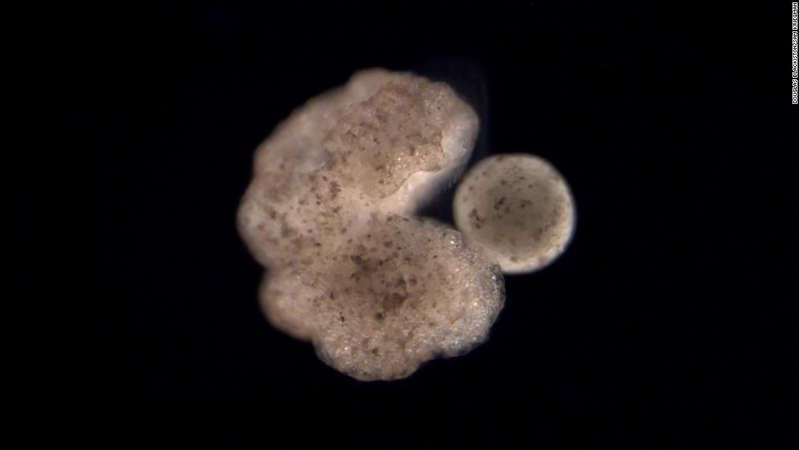
The US scientists who created the first living robots say the life forms, known as xenobots, can now reproduce -- and in a way not seen in plants and animals.
Formed from the stem cells of the African clawed frog (Xenopus laevis) from which it takes its name, xenobots are less than a millimeter (0.04 inches) wide. The tiny blobs were first unveiled in 2020 after experiments showed that they could move, work together in groups and self-heal.
Now the scientists that developed them at the University of Vermont, Tufts University and Harvard University's Wyss Institute for Biologically Inspired Engineering said they have discovered an entirely new form of biological reproduction different from any animal or plant known to science.
"I was astounded by it," said Michael Levin, a professor of biology and director of the Allen Discovery Center at Tufts University who was co-lead author of the new research.
"Frogs have a way of reproducing that they normally use but when you ... liberate (the cells) from the rest of the embryo and you give them a chance to figure out how to be in a new environment, not only do they figure out a new way to move, but they also figure out apparently a new way to reproduce."
Robot or organism?
Stem cells are unspecialized cells that have the ability to develop into different cell types. To make the xenobots, the researchers scraped living stem cells from frog embryos and left them to incubate. There's no manipulation of genes involved."Most people think of robots as made of metals and ceramics but it's not so much what a robot is made from but what it does, which is act on its own on behalf of people," said Josh Bongard, a computer science professor and robotics expert at the University of Vermont and lead author of the study.
"In that way it's a robot but it's also clearly an organism made from genetically unmodified frog cell."
Bongard said they found that the xenobots, which were initially sphere-shaped and made from around 3,000 cells, could replicate. But it happened rarely and only in specific circumstances. The xenobots used "kinetic replication" -- a process that is known to occur at the molecular level but has never been observed before at the scale of whole cells or organisms, Bongard said.
With the help of artificial intelligence, the researchers then tested billions of body shapes to make the xenobots more effective at this type of replication. The supercomputer came up with a C-shape that resembled Pac-Man, the 1980s videogame. They found it was able to find tiny stem cells in a petri dish, gather hundreds of them inside its mouth, and a few days later the bundle of cells became new xenobots.
"The AI didn't program these machines in the way we usually think about writing code. It shaped and sculpted and came up with this Pac-Man shape," Bongard said.
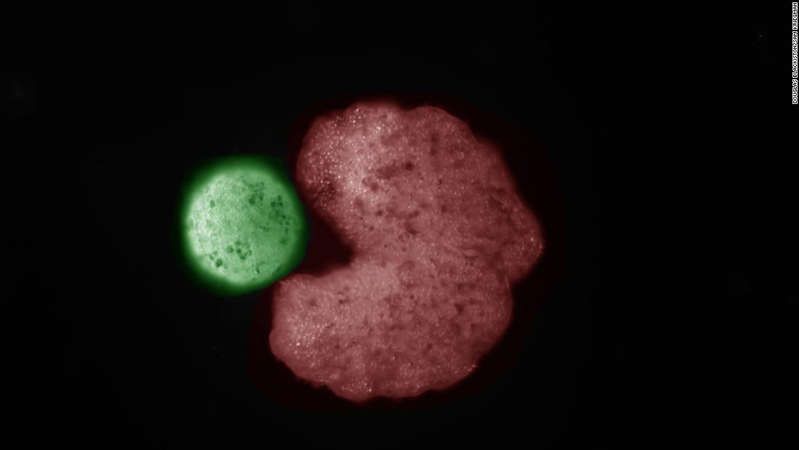
"The shape is, in essence, the program. The shape influences how the xenobots behave to amplify this incredibly surprising process."
The xenobots are very early technology -- think of a 1940s computer -- and don't yet have any practical applications. However, this combination of molecular biology and artificial intelligence could potentially be used in a host of tasks in the body and the environment, according to the researchers. This may include things like collecting microplastics in the oceans, inspecting root systems and regenerative medicine.
While the prospect of self-replicating biotechnology could spark concern, the researchers said that the living machines were entirely contained in a lab and easily extinguished, as they are biodegradable and regulated by ethics experts.
The research was partially funded by the Defense Advanced Research Projects Agency, a federal agency that oversees the development of technology for military use.
"There are many things that are possible if we take advantage of this kind of plasticity and ability of cells to solve problems," Bongard said.
The study was published in the peer-reviewed scientific journal PNAS on Monday.
bulllee
Well-Known Member
Ai-Da: University of Oxford to host robot art exhibition
Published3 June 2019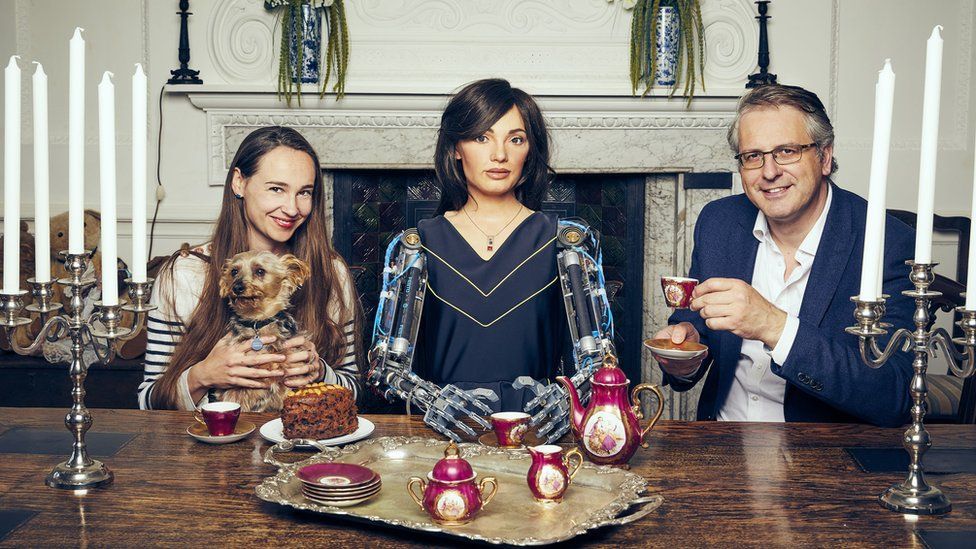
Researcher Lucy Seal (left) and creator Aidan Meller (right) will unveil Ai-Da's work at Oxford University
An exhibition of art created by a humanoid AI robot is set to open at the University of Oxford.
The robot, called Ai-Da after the mathematician Ada Lovelace, uses a robotic arm and a pencil to draw what it sees with a camera in its eye.
Ai-Da's solo exhibition of drawings, paintings, sculptures and video art, called Unsecured Futures, opens from 12 June.
Gallery owner Aidan Meller said Ai-Da was "pioneering a new AI art movement".
"As an AI robot, her artwork uses AI processes and algorithms," he said.
"The work engages us to think about AI and technological uses and abuses in the world today."
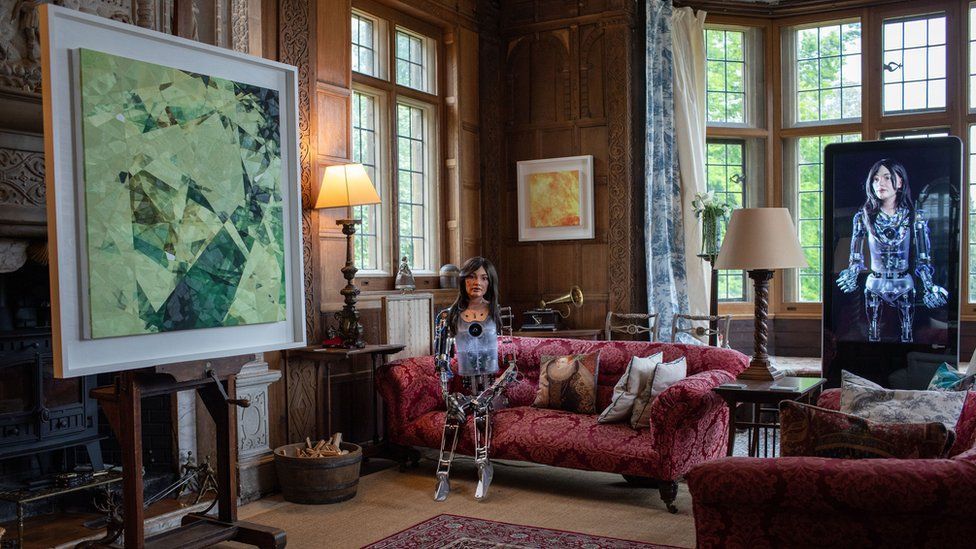
Ai-Da has been designed by the same robotics company that created the robots for HBO's Westworld
Ai-Da was designed by Cornish robotics company Engineered Arts, while engineers in Leeds developed the robotic hand.
The robot calculates a virtual path based on what it sees in front of it, interpreting co-ordinates to create the piece of art.
"We are looking forward to the conversation Ai-Da sparks in audiences," said Lucy Seal, researcher and curator for the project.
The exhibition will run at the Barn Gallery at St John's College until 6 July.
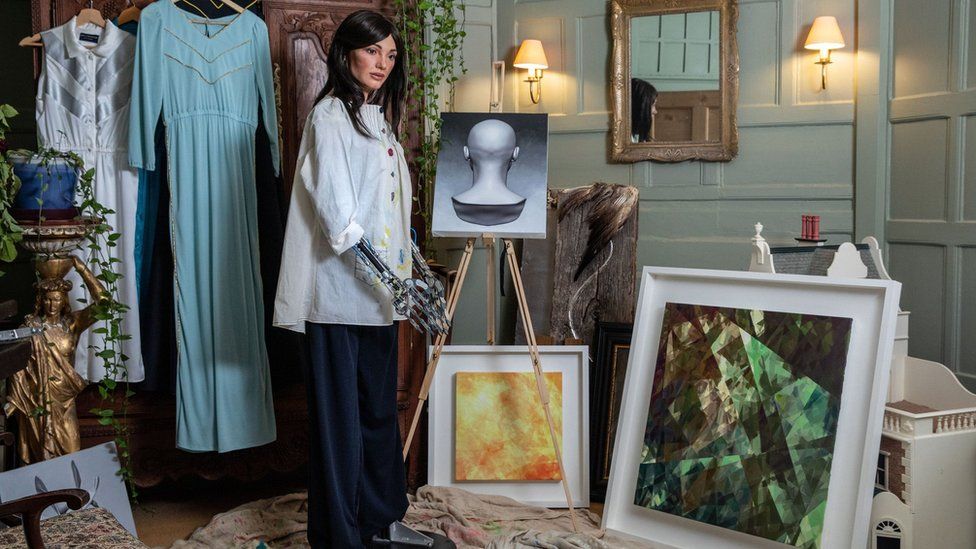
Ai-Da was named after the first female computer programmer
Last edited by a moderator:
Tincandtoke
Well-Known Member
Ai-Da: University of Oxford to host robot art exhibition
Published3 June 2019

Researcher Lucy Seal (left) and creator Aidan Meller (right) will unveil Ai-Da's work at Oxford University
An exhibition of art created by a humanoid AI robot is set to open at the University of Oxford.
The robot, called Ai-Da after the mathematician Ada Lovelace, uses a robotic arm and a pencil to draw what it sees with a camera in its eye.
Ai-Da's solo exhibition of drawings, paintings, sculptures and video art, called Unsecured Futures, opens from 12 June.
Gallery owner Aidan Meller said Ai-Da was "pioneering a new AI art movement".
"As an AI robot, her artwork uses AI processes and algorithms," he said.
"The work engages us to think about AI and technological uses and abuses in the world today."

Ai-Da has been designed by the same robotics company that created the robots for HBO's Westworld
Ai-Da was designed by Cornish robotics company Engineered Arts, while engineers in Leeds developed the robotic hand.
The robot calculates a virtual path based on what it sees in front of it, interpreting co-ordinates to create the piece of art.
"We are looking forward to the conversation Ai-Da sparks in audiences," said Lucy Seal, researcher and curator for the project.
The exhibition will run at the Barn Gallery at St John's College until 6 July.

Ai-Da was named after the first female computer programmer
And the Matrix begins...
Banksy on the dole
Infamous double postView attachment 31937The Gilbert U-238 Atomic Energy Lab was an actual radioactive toy and learning set sold in the early 1950s. The $49.50 set came with four samples of uranium-bearing ores (autunite, torbernite, uraninite, and carnotite), as well as a Geiger-Mueller radiation counter and various other tools.
The set also came with a comic book featuring Dagwood from the popular Blondie comic strip. It was titled "Learn How Dagwood Splits the Atom" and written in conjunction with General Leslie Groves, director of the Manhattan Project.
Radar Magazine dubbed the Atomic Energy Lab one of "the 10 most dangerous toys of all time" in 2006.
Making moderators crazy is a hobby of mine
bulllee
Well-Known Member
Gum with a plant-grown protein reduces COVID-19 transmission by 95%
Stacy Liberatore For Dailymail.com - 2h ago© Provided by Daily Mail
New type of gum has been found to nearly eliminate transmission of the coronavirus by neutralizing the virus in the person's saliva.
A team of scientists led by Penn State University infused gum with a plant-grown protein and found it 'traps' the SARS-CoV-2 virus.
The protein, known as ACE2, prevents the virus from attaching to a host cell in the human body by interacting with SARS-CoV-2's receptor binding domain - this facilitates virus attachment to the receptor and fusion with cell membrane.
When saliva samples from coronavirus patients were exposed to the ACE2 gum, researchers observed 50 mg of the cinnamon-flavored gum reduced viral entry by 95 percent.
The research team is currently working toward obtaining permission to conduct a clinical trial to evaluate whether the approach is safe and effective when tested in people infected with SARS-CoV-2.
Scroll down for video
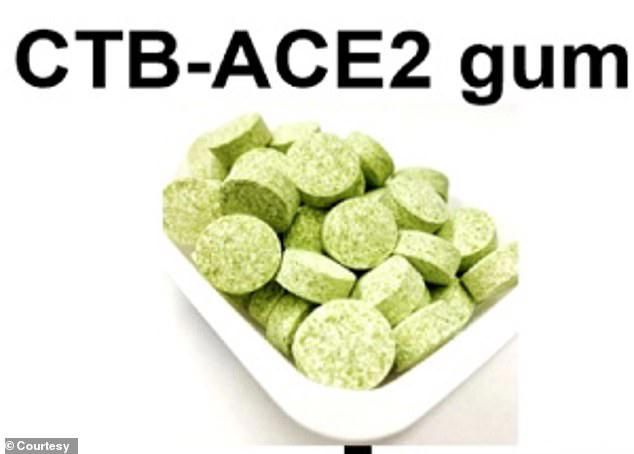
© Provided by Daily Mail(
Henry Daniell at Penn State's School of Dental Medicine, who led the research, said in a statement: 'SARS-CoV-2 replicates in the salivary glands, and we know that when someone who is infected sneezes, coughs, or speaks some of that virus can be expelled and reach others.
'This gum offers an opportunity to neutralize the virus in the saliva, giving us a simple way to possibly cut down on a source of disease transmission.'
Coronavirus gains access to bodily cells by attaching itself to a protein called ACE2 and the new chewing gum was developed with a copy of that protein, allowing it to mimic bodily cells.
This tricks the virus into attaching to chewing gum chemicals, instead of the saliva, where it is neutralized and unable to be transmitted to someone else.
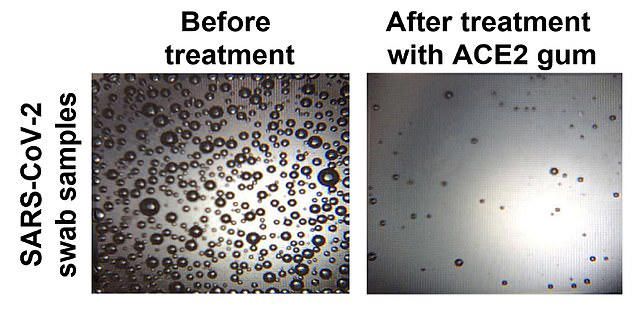
© Provided by Daily Mail(
To test the gum, the team grew ACE2 in plants, paired with another compound that enables the protein to cross mucosal barriers and facilitates binding and incorporated the resulting plant material into cinnamon-flavored gum tablets.
Incubating samples obtained from nasopharyngeal swabs from COVID-positive patients with the gum, they showed that the ACE2 present could neutralize SARS-CoV-2 viruses.
The scientists observed that the gum largely prevented viral particles from entering cells, which was done by blocking the ACE2 receptor on the cells or binding directly to the spike protein.
And the results showed that levels of the viral RNA in the person's saliva were almost undetectable.
Though the research is still in the early stages of development, if the clinical trials prove the gum is safe and effective, it could be given to patients whose infection status is unknown or even for dental check-ups when masks must be removed, to reduce the likelihood of passing the virus to caregivers, according to the researchers.
'We are already using masks and other physical barriers to reduce the chance of transmission,' said Daniell. 'This gum could be used as an additional tool in that fight.'
Read more
bulllee
Well-Known Member
New Zealand to ban cigarettes for future generations
Published1 day ago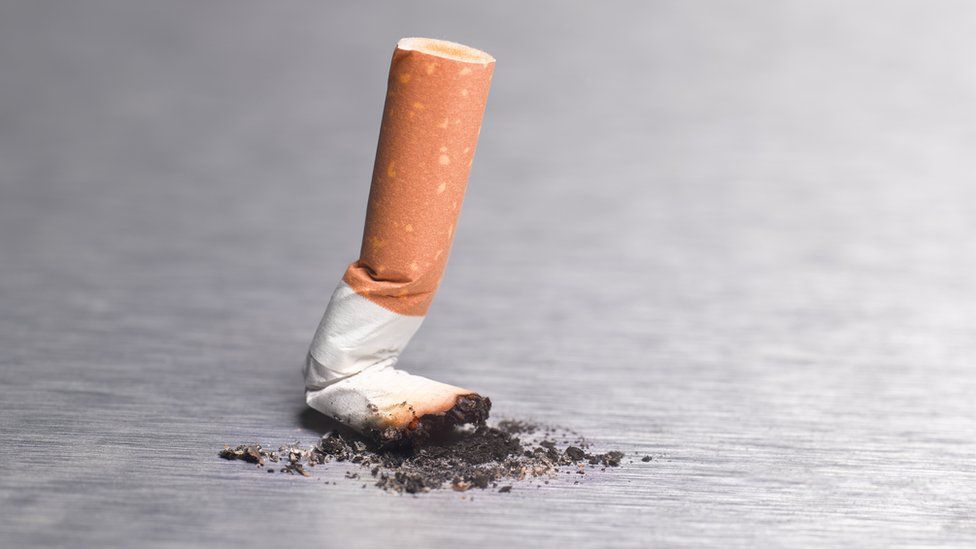
Image caption,
Anyone born after 2008 will not be able to buy cigarettes or tobacco products in their lifetime
New Zealand will ban the sale of tobacco to its next generation, in a bid to eventually phase out smoking.
Anyone born after 2008 will not be able to buy cigarettes or tobacco products in their lifetime, under a law expected to be enacted next year.
"We want to make sure young people never start smoking," Health Minister Dr Ayesha Verall said.
The move is part of a sweeping crackdown on smoking announced by New Zealand's health ministry on Thursday.
Doctors and other health experts in the country have welcomed the "world-leading" reforms, which will reduce access to tobacco and restrict nicotine levels in cigarettes.
"It will help people quit or switch to less harmful products, and make it much less likely that young people get addicted to nicotine," said Prof Janet Hook from the University of Otago.
The crackdown has been met with mixed reactions.
"I reckon it's a good move, really," one man told Reuters news agency. "Because right now there's a lot of young kids walking around with smokes in their mouth. Public are asking how they're getting these smokes.
"And it's also good for myself too because I can save more money."
However, others have warned that the move may create a black market for tobacco - something the health ministry's official impact statement does acknowledge, noting "customs will need more resource to enforce border control".
"This is all 100% theory and 0% substance," Sunny Kaushal, chairman of the Dairy and Business Owners Group, a lobby group for local convenience stores, told New Zealand's Stuff news site. "There's going to be a crime wave. Gangs and criminals will fill the gap".
New Zealand is determined to achieve a national goal of reducing its national smoking rate to 5% by 2025, with the aim of eventually eliminating it altogether.
At the moment, 13% of New Zealand's adults smoke, with the rate much higher among the indigenous Maori population, where it soars to almost a third. Maori also suffer a higher rate of disease and death.
New Zealand's health ministry says smoking causes one in four cancers and remains the leading cause of preventable death for its five million strong population. The industry has been the target of legislators for more than a decade now.
As part of the crackdown announced on Thursday, the government also introduced major tobacco controls, including significantly restricting where cigarettes can be sold to remove them from supermarkets and corner stores.
The number of shops authorised to sell cigarettes will be drastically reduced to under 500 from about 8,000 now, officials say.
In recent years, vaping - smoking e-cigarettes which produce a vapour that also delivers nicotine - has become far more popular among younger generations than cigarettes.
New Zealand health authorities warn however, that vaping is not harmless. Researchers have found hazardous, cancer-causing agents in e-cigarette liquids as well.
But in 2017 the country adopted vaping as a pathway to help smokers quit tobacco.
|
Sponsored by |
|---|
|
|
|